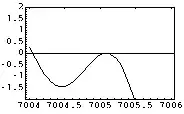Here is an approach.
We give some preliminary results.
The poly-Hurwitz zeta function
The poly-Hurwitz zeta function may initially be defined by the series
$$
\begin{align}
\displaystyle \zeta(s\mid a,b) := \sum_{n=1}^{+\infty} \frac{1}{(n+a)^{s}(n+b)},
\quad \Re a >-1, \, \Re b >-1, \, \Re s>0. \tag1
\end{align}
$$
This special function is a natural extension of the Hurwitz zeta function initially defined as
$$
\zeta(s,a)=\sum_{n=0}^{\infty} \frac{1}{(n+a)^s}, \quad \Re a>0, \Re s>1, \tag2
$$
which is a natural extension itself of the Riemann zeta function initially defined as
$$
\zeta(s)=\sum_{n=1}^{\infty} \frac{1}{n^s}, \quad \Re s>1. \tag3
$$
The poly-Hurwitz function appears in different places with different notations, one may find it here:
[Masri, p. 2 and p. 15 (2004)], [Murty, p. 17 (2006)], [Sinha, p. 45 (2002)]. In this answer we are dealing with a simplified version of a general poly-Hurwitz function.
The series in $(1)$ converges absolutely for $\displaystyle \Re s>0$. Moreover, the convergence of the series is uniform on every
half-plane $$\displaystyle H_{\delta}=\left\{s \in \mathbb{C}, \Re s \geq \delta \right\}, \, \delta \in \mathbb{R},\, \delta>0,$$ therefore the poly-Hurwitz zeta function $\displaystyle \zeta(\cdot \mid a,b)$
is analytic on the half-plane $\displaystyle \Re s>0$.
Let $a$, $b$ and $s$ be complex numbers such that $\Re a >-1, \, \Re b >-1, \, \Re s >0$. One may observe that
$$
\begin{align}
\zeta(s\mid a,b) & = \sum_{n=1}^{+\infty} \frac{1}{(n+a)^{s}(n+b)}\\
& = \sum_{n=1}^{+\infty} \frac{(n+b)+(a-b)}{(n+a)^{s+1}(n+b)}\\
& = \sum_{n=1}^{+\infty} \frac{1}{(n+a)^{s+1}}+(a-b)\sum_{n=1}^{+\infty} \frac{1}{(n+a)^{s+1}(n+b)} \tag4
\end{align}
$$
giving the functional identity
$$
\begin{align}
\zeta(s \mid a,b) = \zeta(s+1,a+1) +(a-b) \zeta(s+1 \mid a,b) \tag5
\end{align}
$$
where $\displaystyle \zeta(\cdot,\cdot)$ is the standard Hurwitz zeta function.
From $(5)$, we obtain by induction, for $n=1,2,3,\ldots $,
$$
\begin{align}
\zeta(s\mid a,b) = \sum_{k=1}^{n}(a-b)^{k-1}\zeta(s+k,a+1) +(a-b)^n\zeta(s+n \mid a,b). \tag6
\end{align}
$$
We use $(6)$ to extend $\displaystyle \zeta(\cdot \mid a,b)$ to a meromorphic function on each open set $\Re s>-n $, $n\geq 1$. Since the Hurwitz zeta function is analytic on the whole complex plane except for a simple pole at $1$ with residue $1$, then from $(6)$ the poly-Hurwitz zeta function $\displaystyle \zeta(\cdot\mid a,b)$ is analytic on the whole complex plane except for a simple pole at $0$ with residue $1$.
The poly-Stieltjes constants
In 1885 Stieltjes has found that the Laurent series expansion around $1$ of the Riemann zeta function
$$
\zeta(1+s) = \frac{1}{s} + \sum_{k=0}^{\infty} \frac{(-1)^{k}}{k!}\gamma_k s^k, \quad s \neq 0,\tag7
$$ is such that the coefficients of the regular part of the expansion are given by
$$
\begin{align}
\gamma_k& = \lim_{N\to \infty}\left(\sum_{n=1}^N \frac{\log^k n}{n}-\frac{\log^{k+1} \!N}{k+1}\right).
\end{align} \tag8
$$ Euler was the first to define a constant of this form (1734)
$$
\begin{align}
\gamma & = \lim_{N\to\infty}\left(1+\frac12+\frac13+\cdots+\frac1N-\log N\right)=0.577215\ldots.
\end{align}
$$ The constants $\displaystyle \gamma_k$ are called the Stieltjes constants and due to the fact that $\displaystyle \gamma_0=\gamma$ they are sometimes called the generalized Euler's constants.
Similarly, Wilton (1927) and Berndt (1972) established that the Laurent series expansion in the neighbourhood of $1$ of the Hurwitz zeta function
$$
\begin{align} \zeta(1+s,a)
= \frac1s+\sum_{k=0}^{\infty}\frac{(-1)^{k}}{k!} \gamma_{k}(a)\:s^{k}, \quad \Re a>0, \,s\neq 0, \tag{9}
\end{align}
$$ is such that the coefficients of the regular part of the expansion are given by
$$
\begin{align}
\gamma_k(a)& = \lim_{N\to \infty}\left(\sum_{n=0}^N \frac{\log^k (n+a)}{n+a}-\frac{\log^{k+1} (N+a)}{k+1}\right), \quad \Re a>0,
\end{align} \tag{10}
$$
with $\displaystyle \gamma_{0}(a)=-\psi(a)=-\Gamma'(a)/\Gamma(a)$. The coefficients $\gamma_k(a)$ are called the generalized Stieltjes constants.
We have seen from $(6)$ that the poly-Hurwitz zeta function admits a Laurent series expansion around $0$. Let's denote by $\displaystyle\gamma_k(a,b)$ the coefficients of the regular part of $\displaystyle \zeta(\cdot\mid a,b)$ around $0$. I will call these coefficients the poly-Stieltjes constants.
Do we have an analog of $(10)$ for $\displaystyle\gamma_k(a,b)$?
The following result is new.
Theorem 1. Let $a,b$ be complex numbers such that $\Re a >-1, \, \Re b >-1$. Consider
The poly-Hurwitz zeta function $$
\begin{align}
\zeta(s\mid a,b) := \sum_{n=1}^{+\infty} \frac{1}{(n+a)^{s}(n+b)},
\quad \Re s>0. \tag{11}
\end{align}
$$
Then the meromorphic extension of $\displaystyle \zeta(\cdot\mid a,b)$ admits the following Laurent series expansion around $0$,
$$
\zeta(s \mid a,b) = \frac{1}{s} + \sum_{k=0}^{+\infty} \frac{(-1)^{k}}{k!}\gamma_k(a,b) s^k, \quad s \neq 0,\tag{12}
$$ where the poly-Stieltjes constants $\displaystyle \gamma_k(a,b)$ are given by $$
\begin{align}
\gamma_k(a,b)& = \lim_{N\to+\infty}\left(\sum_{n=1}^N \frac{\log^k (n+a)}{n+b}-\frac{\log^{k+1} \!N}{k+1}\right)
\end{align} \tag{13}
$$ with $$ \gamma_{0}(a,b)=-\psi(b+1)=-\Gamma'(b+1)/\Gamma(b+1). \tag{14}$$
Proof. Let $a,b$ be complex numbers such that $\Re a >-1, \, \Re b >-1$.
We first assume $\Re s>0$. Observing that, for each $n \geq 1$,
$$
\left|\sum_{k=0}^{\infty}\frac{\log^k(n+a)}{n+b}\frac{(-1)^{k}}{k!}s^k\right| \leq \sum_{k=0}^{\infty}\left|\frac{\log^k(n+a)}{n+b}\right|\frac{|s|^k }{k!}<\infty
$$ and that
$$
\sum_{n=1}^{\infty}\left|\sum_{k=0}^{\infty}\frac{\log^k(n+a)}{n+b}\frac{(-1)^{k}}{k!}s^k\right|=\sum_{n=1}^{\infty}\left|\frac1{(n+a)^s(n+b)}\right| =
\sum_{n=1}^{\infty}\frac1{|n+a|^{\Re s}|n+b|}<\infty,$$
we obtain
$$
\begin{align}
&\sum_{k=0}^{\infty}\frac{(-1)^{k}}{k!}\lim_{N\to+\infty}\left(\sum_{n=1}^N\frac{\log^k(n+a)}{n+b}-\frac{\log^{k+1} \!N}{k+1}\right) s^k \\\\
&= \lim_{N\to+\infty}\sum_{k=0}^{\infty} \frac{(-1)^{k}}{k!}\left(\sum_{n=1}^N\frac{\log^k(n+a)}{n+b}-\frac{\log^{k+1} \!N}{k+1}\right) s^k \\\\
&=\lim_{N\to+\infty}\sum_{k=0}^{\infty}\left(\sum_{n=1}^N\frac{(-1)^{k}}{k!}\frac{\log^k(n+a)}{n+b}s^k -\frac{(-1)^{k}}{k!}\frac{\log^{k+1} \!N}{k+1}s^k\right) \\\\
&=\lim_{N\to+\infty}\left(\sum_{n=1}^N\sum_{k=0}^{\infty}\frac{(-1)^{k}}{k!}\frac{\log^k(n+a)}{n+b}s^k -\sum_{k=0}^{\infty}\frac{(-1)^{k}}{k!}\frac{\log^{k+1} \!N}{k+1}s^k\right) \\\\
&=\lim_{N\to+\infty}\left(\sum_{n=1}^N\frac1{(n+a)^s(n+b)} +\frac1{N^s}-\frac1s\right) \\\\
&=\zeta(s \mid a,b)-\frac1{s}
\end{align}
$$ as desired. Then, using $(6)$, we extend the preceding identity by analytic continuation to all $s \neq 0$. To prove $(14)$, we start from a standard series representation of the digamma function (see Abram. & Steg. p. 258 6.3.16):
$$
\begin{align}
-\psi(b+1) &= \gamma - \sum_{n=1}^{\infty} \left( \frac1n - \frac1{b+n} \right) \\
&=\lim_{N\to+\infty}\left(\gamma - \sum_{n=1}^N\left( \frac1n - \frac1{b+n} \right)\right)\\
&=\lim_{N\to+\infty}\left(\left(\sum_{n=1}^N\frac1{b+n} -\ln N\right)-\left(\sum_{n=1}^N\frac1n-\ln N-\gamma \right)\right)\\
&=\lim_{N\to+\infty}\left(\sum_{n=1}^N\frac1{b+n} -\ln N\right)\\\\
&=\gamma_0(a,b)
\end{align}
$$ using $(13)$.
$\qquad \qquad \qquad \qquad \qquad \qquad \qquad \qquad \qquad \qquad \qquad \qquad \qquad \qquad \qquad \qquad \qquad \qquad \qquad \Box$
One of the consequences of Theorem 1 is the new possibility to express some series in terms of the poly-Stieltjes constants.
Theorem 2. Let $a,b,c$ be complex numbers such that $\Re a >-1, \, \Re b >-1, \, \Re c >-1$.
Then
$$
\begin{align}
(b-a)\sum_{n=1}^{+\infty} \frac{\log (n+c)}{(n+a)(n+b)}=\gamma_1(c,a)-\gamma_1(c,b), \tag{15}
\end{align}
$$ similarly
$$
\begin{align}
\sum_{n=1}^{+\infty} \frac1{n+b}\left({\log (n+a)-\log (n+c)}\right)=\gamma_1(a,b)-\gamma_1(c,b), \tag{16}
\end{align}
$$ with the poly-Stieltjes constant
$$\gamma_1(a,b) = \lim_{N\to+\infty}\left(\sum_{n=1}^N \frac{\log (n+a)}{n+b}-\frac{\log^2 \!N}2\right).
$$
Proof. Let $a,b,c$ be complex numbers such that $\Re a >-1, \, \Re b >-1, \, \Re c >-1$.
We have
$$
(b-a)\frac{\log (n+c)}{(n+a)(n+b)}=\frac{\log (n+c)}{n+a}-\frac{\log (n+c)}{n+b}
$$ giving, for $N\geq1$,
$$
\begin{align}
(b-a)&\sum_{n=1}^N \frac{\log (n+c)}{(n+a)(n+b)}=\\\\
& \left(\sum_{n=1}^N\frac{\log (n+c)}{n+a}-\frac{\log^2 \!N}2\right)-\left(\sum_{n=1}^N\frac{\log (n+c)}{n+b}-\frac{\log^2 \!N}2\right) \tag{17}
\end{align}
$$
letting $N \to \infty$ and using $(13)$ gives $(15)$.
We have, for $N\geq1$,
$$
\begin{align}
&\sum_{n=1}^N \frac1{n+b}\left({\log (n+a)-\log (n+c)}\right)\\\\
&= \left(\sum_{n=1}^N\frac{\log (n+a)}{n+b}-\frac{\log^2 \!N}2\right)-\left(\sum_{n=1}^N\frac{\log (n+c)}{n+b}-\frac{\log^2 \!N}2\right) \tag{18}
\end{align}
$$
letting $N \to \infty$ and using $(13)$ gives $(16)$.
$\qquad \qquad \qquad \qquad \qquad \qquad \qquad \qquad \qquad \qquad \qquad \qquad \qquad \qquad \qquad \qquad \qquad \qquad \qquad \Box$
Juantheron's integral
Let’s first give a numerical evaluation of Juantheron’s integral.
I would like to thank Jonathan Borwein and David H. Bailey who obtained the result below to $1000$ digits, in just 3.9 seconds run time, using David's new MPFUN-MPFR software, along with the tanh-sinh quadrature program included with the MPFUN-MPFR package.
They also tried the integral with David's MPFUN-Fort package, which has a completely different underlying multiprecision system, and they obtained the same result below.
Finally, they computed the integral with Mathematica $11.0$; it agreed with the result below, although it required about 10 times longer to run.
Proposition 1. We have
$$
\begin{align} \int_{0}^{\Large\frac{\pi}2}\!&\frac1{(1+x^2)(1+\tan x)}\mathrm dx\\\\=
0.&59738180945180348461311323509087376430643859042555\\
&67307703207161550311033249824121789098990404474443\\
&73300942847961727020952797366230453350097928752529\\
&62099371263365268445580755896768905606293308536674\\
&89639352215352393870280616186538538722285601087082\\
&81730013060929540132583577240799018025603130403772\\
&83596189879605956759516344861849456740112012597646\\
&30195536341071109827787231788650530475635336662512\\
&50757672078320586388500276160658476344052492489409\\
&64026178233152015087197531148322444147655936720008 \tag{19}\\
&40650450631581050321100329502169853063154902765446\\
&58804861176982696627707544105655815406116180984371\\
&54148587721902800400109013880620460529382772599713\\
&06874977209651994186527207589425408866256042399213\\
&80515694164361264997143539392018681691584285790381\\
&65536517701019826846772718498479534803417547866296\\
&23842162877309354675086691711521468623807334908897\\
&71491673168051054009130049879837629516862688171756\\
&13790927986073268994254629238035029442300668334396\\
&901581838911515359223628586133156893962372426055\cdots
\end{align}
$$
David H. Bailey confirmed that Mathematica $11.0$, in spite of the great numerical precision, could not find a closed-form of the integral.
The next result proves that the OP integral admits a closed form in terms of the poly-Stieltjes constants.
Proposition 2. We have
$$
\begin{align} \int_{0}^{\Large\frac{\pi}2}\!\!\frac1{(1+x^2)(1+\tan x)}\mathrm dx
&=\frac{(e^2+1)^2}{2(e^4+1)}\arctan \! \frac{\pi}{2}-\frac{e^4-1}{4(e^4+1)}\log\left(1+\frac{\pi^2}{4}\right)\\\\
&+\frac{64 \pi^2\log 3}{(\pi^2+16)(9\pi^2+16)} \\\\
&+\frac{\Im}{2\pi}\gamma_1\!\left(\!\frac34,\frac34 +\frac{i}{\pi}\!\right) -\frac{\Im}{2\pi}\gamma_1\!\left(\!\frac14,\frac34 +\frac{i}{\pi}\!\right)\tag{20}\\\\ &+\frac{\Im}{2\pi}\gamma_1\!\left(\!\frac34,\frac14 -\frac{i}{\pi}\!\right) -\frac{\Im}{2\pi}\gamma_1\!\left(\!\frac14,\frac14 -\frac{i}{\pi}\!\right)
\end{align}
$$ with the poly-Stieltjes constant
$$\gamma_1(a,b) = \lim_{N\to+\infty}\left(\sum_{n=1}^N \frac{\log (n+a)}{n+b}-\frac{\log^2 \!N}2\right). $$
Proof. We proceed in three steps.
Step 1. One may write
$$
\require{cancel}
\begin{align}
&\int_{0}^{\Large\frac{\pi}{2}}\frac{1}{(1+x^2)(1+\tan x)}\mathrm dx \\
&=\int_{0}^{\Large\frac{\pi}{2}}\frac{\cos x}{(1+x^2)(\cos x+\sin x)}\mathrm dx\\
&=\frac12\int_{0}^{\Large\frac{\pi}{2}}\frac{(\cos x+\sin x)+(\cos x-\sin x)}{(1+x^2)(\cos x+\sin x)}\mathrm dx\\
&=\frac12\int_{0}^{\Large\frac{\pi}{2}}\!\frac{1}{1+x^2}\mathrm dx+\frac12\int_{0}^{\Large\frac{\pi}{2}}\frac{1}{(1+x^2)}\frac{(\cos x-\sin x)}{(\cos x+\sin x)}\mathrm dx\\
&=\frac12 \arctan\! \frac{\pi}{2}+\frac12\int_{0}^{\Large\frac{\pi}{2}}\frac{1}{1+x^2}\tan (x-\pi/4)\:\mathrm dx\\
&=\frac12 \arctan\! \frac{\pi}{2}+\frac12\int_{-\Large\frac{\pi}{4}}^{\Large\frac{\pi}4}\frac{1}{1+(x+\pi/4)^2}\tan x \:\mathrm dx\\
&=\frac12 \arctan\! \frac{\pi}{2}+\frac12\int_0^{\Large\frac{\pi}4}\left(\frac1{1+(x+\pi/4)^2}-\frac1{1+(x-\pi/4)^2}\right)\tan x \:\mathrm dx\\
&=\frac12 \arctan\! \frac{\pi}{2}-\frac{\Im}2 \!\int_{0}^{\Large\frac{\pi}{4}}\!\!\left(\!\frac1{x+\pi/4+i}+\frac1{x-\pi/4-i}\!\right) \tan x \:\mathrm dx \tag{21}
\end{align}
$$
Let’s evaluate the latter integral.
Step 2. One may recall that the tangent function, as a meromorphic function, can be expressed as an infinite sum of rational functions:
$$
\tan x = \sum_{n=0}^{+\infty} \frac{2x}{\pi^2 (n+1/2)^2-x^2}, \quad x \neq \pm \pi/2, \pm 3\pi/2,\pm 5\pi/2,\ldots. \tag{22}
$$
We have the inequality
$$
\sup_{x \in [0,\pi/4]}\left|\frac{2x}{\pi^2 (n+1/2)^2-x^2}\right|\leq \frac1{(n+1/2)^2}, \quad n=0,1,2,\ldots, \tag{23}
$$ the convergence in $(22)$ is then uniform on $[0,\pi/4]$. Thus, plugging $(22)$ into $(21)$, we are allowed to integrate $(21)$ termwise.
Each term, via a partial fraction decomposition, is evaluated to obtain
$$
\begin{align}
\int_{0}^{\Large\frac{\pi}4}\!&\left(\!\frac1{x+\pi/4+i}+\frac1{x-\pi/4-i}\!\right)\frac{2x}{\pi^2 (n+1/2)^2-x^2}\:\mathrm dx\\
&=\frac{2\tau}{\pi^2 (n+1/2)^2-\tau^2}\log \left( \frac{4\tau-\pi}{4\tau+\pi}\right)\\
&+\frac1{\pi}\frac1{(n+1/2+\tau/\pi)}\left(\log\!\left(n+\frac34\right)-\log\!\left(n+\frac14\right) \right)\\
&+\frac1{\pi}\frac1{(n+1/2-\tau/\pi)}\left(\log\!\left(n+\frac34\right)-\log\!\left(n+\frac14\right) \right)
\end{align} \tag{24}
$$
where for the sake of convenience we have set $\tau:=\pi/4+i$.
Step 3. We sum $(24)$ from $n=0$ to $\infty$ obtaining
$$
\begin{align}
\int_{0}^{\Large\frac{\pi}{4}}\!&\left(\!\frac1{x+\pi/4+i}+\frac1{x-\pi/4-i}\!\right) \tan x \:\mathrm dx\\
&=\sum_{n=0}^{\infty}\frac{2\tau}{\pi^2 (n+1/2)^2-\tau^2}\log \left( \frac{4\tau-\pi}{4\tau+\pi}\right)\\
&+\frac1{\pi}\sum_{n=0}^{\infty}\frac1{(n+1/2+\tau/\pi)}\left(\log\!\left(n+\frac34\right)-\log\!\left(n+\frac14\right) \right)\\
&+\frac1{\pi}\sum_{n=0}^{\infty}\frac1{(n+1/2-\tau/\pi)}\left(\log\!\left(n+\frac34\right)-\log\!\left(n+\frac14\right) \right), \tag{25}
\end{align}
$$ then, singling out the first terms in the two last series and using Theorem $2$ $(16)$, we get
$$
\begin{align}
\int_{0}^{\Large\frac{\pi}{4}}\!&\left(\!\frac1{x+\pi/4+i}+\frac1{x-\pi/4-i}\!\right) \tan x \:\mathrm dx\\
&=\tan \tau \log \left( \frac{4\tau-\pi}{4\tau+\pi}\right)
+\frac{4\pi}{\pi^2 -4\tau^2}\log 3
\\&+\frac1{\pi}\gamma_1\!\left(\!\frac34,\frac12 +\frac{\tau}{\pi}\!\right) -\frac1{\pi}\gamma_1\!\left(\!\frac14,\frac12 +\frac{\tau}{\pi}\!\right)\tag{26}\\ &+\frac1{\pi}\gamma_1\!\left(\!\frac34,\frac12 -\frac{\tau}{\pi}\!\right) -\frac1{\pi}\gamma_1\!\left(\!\frac14,\frac12 -\frac{\tau}{\pi}\!\right)
\end{align} $$ and the substitution $\tau=\pi/4+i$ gives the desired result.
$\qquad \qquad \qquad \qquad \qquad \qquad \qquad \qquad \qquad \qquad \qquad \qquad \qquad \qquad \qquad \qquad \qquad \qquad \qquad \Box$
Achille Hui's conjecture is true.
Achille Hui has announced in the comments that the OP integral is equal to
$$
\begin{align}
\frac{\arctan(\frac{\pi}{2}) - t\log\sqrt{1+\frac{\pi^2}{4}}}{1+t^2}+\frac{\pi^2}4 \sum_{n=0}^{\infty}\frac{ (2n+1)\left(\log\left(n+\frac34\right)-\log\left(n+\frac14\right)\right) }{ \left(1+\pi^2\left(n+\frac14\right)^2\right)\left(1+\pi^2\left(n+\frac34\right)^2\right) } \tag{27}
\end{align}
$$ with $\displaystyle t := \tanh(1)$.
The first term in $(27)$, with a little algebra is seen to be equal to the sum of the first two terms on the right hand side of $(20)$.
We establish the veracity of the conjecture using Proposition $2$ and using the next result.
Proposition 3. We have
$$
\begin{align} &\frac{\pi^2}4 \sum_{n=0}^{\infty}\frac{ (2n+1)\left(\log\left(n+\frac34\right)-\log\left(n+\frac14\right)\right) }{ \left(1+\pi^2\left(n+\frac14\right)^2\right)\left(1+\pi^2\left(n+\frac34\right)^2\right) }\\\\
&=\frac{64 \pi^2\log 3}{(\pi^2+16)(9\pi^2+16)} \\\\
&+\frac{\Im}{2\pi}\gamma_1\!\left(\!\frac34,\frac34 +\frac{i}{\pi}\!\right) -\frac{\Im}{2\pi}\gamma_1\!\left(\!\frac14,\frac34 +\frac{i}{\pi}\!\right)\tag{28}\\\\ &+\frac{\Im}{2\pi}\gamma_1\!\left(\!\frac34,\frac14 -\frac{i}{\pi}\!\right) -\frac{\Im}{2\pi}\gamma_1\!\left(\!\frac14,\frac14 -\frac{i}{\pi}\!\right)
\end{align}
$$ with the poly-Stieltjes constant
$$\gamma_1(a,b) = \lim_{N\to+\infty}\left(\sum_{n=1}^N \frac{\log (n+a)}{n+b}-\frac{\log^2 \!N}2\right).$$
Proof. Observe that the first term of the series on the left hand side of $(28)$, given by $n=0$, is just equal to
$$
\frac{64 \pi^2\log 3}{(\pi^2+16)(9\pi^2+16)}.
$$ By a partial fraction decomposition, one may check that
$$
\begin{align}
\frac{\pi^2}4 &\frac{ (2n+1) }{ \left(1+\pi^2\left(n+\frac14\right)^2\right)\left(1+\pi^2\left(n+\frac34\right)^2\right) }
=\frac{\Im}{2\pi}\left(\!\frac1{n+\frac34+\frac{i}{\pi}}-\frac1{n+\frac14+\frac{i}{\pi}}\!\right) \tag{29}
\end{align}
$$
then, multiplying $(29)$ by $\left(\log\!\left(n+\frac34\right)-\log\!\left(n+\frac14\right)\right)$ and summing from $n=1$ to $\infty$ we get, using Theorem $2$ $(16)$, the result $(28)$.
$\qquad \qquad \qquad \qquad \qquad \qquad \qquad \qquad \qquad \qquad \qquad \qquad \qquad \qquad \qquad \qquad \qquad \qquad \qquad \Box$




